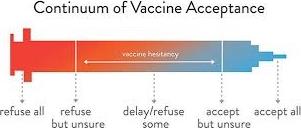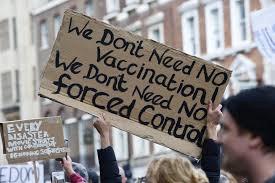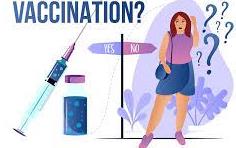 During the first week in May, it was estimated that 34 percent of the U.S. population have been fully vaccinated against COVID. Approximately 150 million have received their first dose and 70 percent over the age of 70 are fully vaccinated. The Administration has set a goal of vaccinating 70 percent of the U.S. population by July 4th since in the region of 75-80 percent of our population should be immune to the predominant strain and variants of SARS-CoV-2 virus. Experience in South Africa, India and the E.U. has demonstrated that a population with a high level of susceptibility and with an increasing incidence rate will result in the evolution of mutants. These may be more infectious and have greater pathogenicity than the original January 2020 strain thereby delaying effective control of the pandemic.
During the first week in May, it was estimated that 34 percent of the U.S. population have been fully vaccinated against COVID. Approximately 150 million have received their first dose and 70 percent over the age of 70 are fully vaccinated. The Administration has set a goal of vaccinating 70 percent of the U.S. population by July 4th since in the region of 75-80 percent of our population should be immune to the predominant strain and variants of SARS-CoV-2 virus. Experience in South Africa, India and the E.U. has demonstrated that a population with a high level of susceptibility and with an increasing incidence rate will result in the evolution of mutants. These may be more infectious and have greater pathogenicity than the original January 2020 strain thereby delaying effective control of the pandemic.
A number of surveys have been conducted to determine the acceptability of the two mRNA vaccines (Pfizer and Moderna) and the adenovirus-vectored single-dose J&J product. Among all three major ethnic groups, 13 to16 percent have stated that they absolutely are unwilling to receive the vaccine. Approximately 25 percent of our population is following a wait-and-see approach and about 15 percent, especially those under 30 years of age will receive a vaccine ‘when convenient’. It is apparent that a relatively high proportion the black population is hesitant to receive any of the vaccines. Rural residents are more likely to be opposed to vaccination, as are male members of the Republican Party. The FDA has approved vaccination of children 12 years of age and up, but it is evident that approximately a third of parents are reluctant to have their children vaccinated over the short term.
 Vaccine reluctance is evident in the declining number of vaccinations on a daily basis. At the peak, three million doses were administered in a single day, mainly through mass vaccination sites. The Administration is now relying on approximately 40,000 pharmacies and primary care facilities including rural clinics and mobile vaccine units. Given the number of those categorically opposed to receiving vaccine, children under the age of 12 and individuals who are ineligible for vaccination based on health considerations, it appears doubtful that herd immunity will be achieved by the end of summer unless those not wishing to be vaccinated can be convinced to transition to the recipient column.
Vaccine reluctance is evident in the declining number of vaccinations on a daily basis. At the peak, three million doses were administered in a single day, mainly through mass vaccination sites. The Administration is now relying on approximately 40,000 pharmacies and primary care facilities including rural clinics and mobile vaccine units. Given the number of those categorically opposed to receiving vaccine, children under the age of 12 and individuals who are ineligible for vaccination based on health considerations, it appears doubtful that herd immunity will be achieved by the end of summer unless those not wishing to be vaccinated can be convinced to transition to the recipient column.
In a recent interview, the Surgeon General, Dr. Vivek Murthy provided a perspective on how the Administration will convince the hesitant to receive a vaccine. He believes that it is important to de-politicize vaccination. To this end, it would be extremely beneficial for President Biden to credit former President Trump and his Administration with the foresight to establish Operation Warp Speed. This made vaccine available at the end of December 2020 and contributed to an adequate supply by the second quarter of 2021. Concurrently it would be helpful for former President Trump to encourage the hesitant, especially among his supporters to receive a vaccine as a patriotic and public-spirited gesture to expedite control of infection. A joint statement appears unlikely, but separate messages of encouragement in the form of alternating sequential public service announcements on mainstream and social media would be extremely helpful in defusing opposition to vaccination.
 It is pointed out that 90 percent of the Congressional Physicians’ Caucus has been vaccinated along with the former President and First Lady and members of both Administrations. All living former Presidents received their vaccines in public and have consistently promoted acceptance.
It is pointed out that 90 percent of the Congressional Physicians’ Caucus has been vaccinated along with the former President and First Lady and members of both Administrations. All living former Presidents received their vaccines in public and have consistently promoted acceptance.
It is generally considered that establishing trust in the three vaccines that have received emergency use authorization are all safe and effective. Previously EGG-NEWS listed reasons advanced for COVID vaccine hesitancy with appropriate counter arguments based on established and incontrovertible scientific knowledge
It is important to recognize that although we have made progress in reducing the impact of COVID over thirteen months, on May 9th there were 41,000 new cases diagnosed although this figure was a 30 percent reduction over April 25th, two weeks previously. On May 9th one million COVID tests were administered with the national positive rate below five percent although regional ‘hot-spots’ persist. Notwithstanding progress in control there are still 39,000 in hospital being treated for acute COVID and 667 people died on May 9th adding to the total of 581,000 confirmed deaths from COVID, although it is recognized that this figure is an underestimate.
It is to the credit of poultry processors and red meat packers that vaccination campaigns have been completed in plants resulting in high levels of acceptance.
Despite relaxation of masking and other social modalities, COVID must be regarded as a serious disease given the number of cases and fatalities and long-term effects. The disease will not simply disappear and with the emergence of variants COVID will persist with continuing impacts on our way of life and economy.
Vaccination not only effectively protects the recipient, it reduces the possibility of spreading infection to family members and the community. The virus does not respect location, political or religious persuasion or ethnicity. We have a collective responsibility to be vaccinated and in the intermediate term to practice common sense measures to prevent dissemination of virus. Adherence to the recommendations of the Centers for Disease Control and Prevention and following the advice of responsible physicians will hasten the end of this disease that represents the worst public health crisis in 100 years.